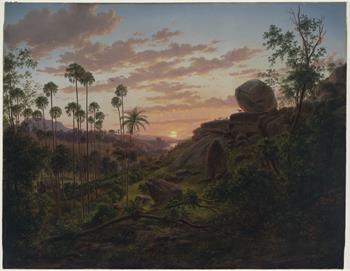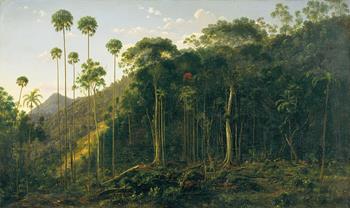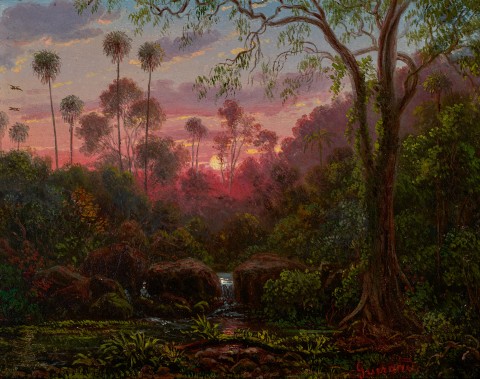ON THE AMERICKAN CREEK NEAR WOLLONGONG, c.1859 – 61
EUGENE VON GUÉRARD
oil on academy board
18.0 x 23.0 cm
signed lower right: Guérard
inscribed with title verso: On the Americkan Creek near Woolongong [sic.]/ N. S. W.
bears framers’ label verso: Reeves & Sons, London
bears inscription on frame verso: Bought by Lady Clarke / 1970 from / Hans Heysen Collection / Malvern Town Hall …
Private collection
The Hans Heysen Collection, Leonard Joel, Melbourne, 18 – 19 June 1970, lot 102
(as ‘On the Amerikan Creek, near Wollongong’)
Lady Clarke, Melbourne
Sotheby’s, Melbourne, 2 – 3 May 2000, lot 55
The Cbus Collection of Australian Art, Melbourne, acquired from the above
Figures & Landscapes: Curated works from The Cbus Collection of Australian Art and the Latrobe Regional Gallery Permanent Collection, Latrobe Regional Gallery, Victoria, 16 December 2017 – 11 March 2018
on long term loan to Wollongong City Gallery, New South Wales
Bruce, C., Comstock, E., and McDonald, F., Eugene von Guérard: A German Romantic in the Antipodes, Alister Taylor, Sydney, 1982, cat. 54, p. 212 (as ‘[American Creek near Wollongong, c.1860]’)
Nainby, B., Stanhope, Z., and Furlonger, K., The Cbus Collection of Australian Art, in association with Latrobe Regional Gallery, Melbourne, 2009, pp. 16, 24 (illus.) 236
Cabbage Tree Forest, American Creek, New South Wales, 1860, oil on canvas, 51.2 x 85.5 cm, in the collection of Wollongong Art Gallery, New South Wales
Figtree on American Creek near Wollongong, 1861, oil on canvas, 83.7 x 66.1 cm, in the collection of the Art Gallery of New South Wales, Sydney
220254 EUGENE VON GUERARD Sunset in NSW, 1865.jpg

Eugene von Guérard’s On the Americkan Creek near Woolongong, c.1859 – 61 is one of a group of important works inspired by the artist’s December 1859 sketching expedition to the Illawarra region of New South Wales.1 In the lush subtropical rainforest that thrived with the protection of the Illawarra escarpment in this humid coastal region 80 kilometres south of Sydney, the artist immersed himself in Alexander von Humboldt’s ‘grand theatre of tropical nature.’2 In Humboldt’s hugely influential publications the ground-breaking natural scientist had urged artists to travel to the new worlds to capture ‘the true image of the varied forms of nature … in the humid mountain valleys of the tropical world.’3 ‘Nowhere does she [nature] more deeply impress us with a sense of her greatness,’ he wrote, ‘nowhere does she speak to us more forcibly than in the tropical world.’4
In travelling into the Illawarra von Guérard followed in the footsteps of a succession of European botanists, notably Alan Cunningham, and artists, including Augustus Earle, Conrad Martens, George French Angas and, in 1859, Joseph Selleny, the Austrian artist who travelled on the Novara expedition artist with an eminent geologist, Ferdinand von Hochstetter, with whom von Guérard shared a professional association. Von Guérard’s close associate, Ferdinand von Mueller, had undertaken Humboldt-focused research there only a few years before the artist set out on his expedition.5
Of the six days von Guérard spent in the Wollongong region, Wednesday 7 December, 1859, the day the sketches associated with the present work were created, was the day of most intense activity. As the artist hacked his way through dense tropical vegetation on the American Creek – named for the Canadian cedar getters who made camp there in the 1840s – he produced ten drawings, eight in his sketchbook and two on larger sheets. And on that one highly productive day, he sketched the subjects for three of his Illawarra canvases: A Figtree on the American Creek, near Wollongong, NSW, 1861 (Art Gallery of New South Wales); Sunset, New South Wales, 1865 and On the Americkan Creek near Woolongong (both in the State Library of New South Wales).
220254 EUGENE VON GUERARD Cabbage tree forest, American Creek, New South Wales.jpg

Like Sunset, New South Wales, von Guérard’s On the Americkan Creek is a composite of two drawings. By combining aspects of the view taken from two slightly different vantage points, he was able to place the waterfall in the centre of the composition and depict the towering palms – for Humboldt ‘the loftiest and most stately of all vegetable forms’ – behind it, their forms dramatically silhouetted against a fiery sunset.6 He framed his view of this dark and secluded pocket of the rainforest with a vine-covered fig-tree (one of Humboldt’s privileged subjects), and emphasized its inaccessibility with a foreground of water, rocks and a fern-covered log. The viewer’s attention is led upwards, from the light reflected on the water, to the sun directly above it, and to Humboldt’s revered ‘tall and slender’ palms with their crowns of ‘shining, fan-like, or pinnated leaves.’7 The composition is further unified by the fierce red of the tropical sunset which spreads through the work, suffusing the clouds and higher vegetation with colour, and reaching down to the depths of the forest floor.
In keeping with Humboldt’s requirements of the artist, von Guérard portrayed individual species – the cabbage tree palms (Livistona Australis), the Moreton Bay Fig Ficus macrophylla, its trunk wrapped in vines and the epiphytic bird’s nest ferns (Asplenium nidus) – with botanical accuracy, in their natural groupings and in their environmental context. He also responded as an artist, the unruly vigour of tropical growth expressed in the energy of his brushwork. His experience of the ‘greatness’ of the tropical world on that particular day is captured in the tiny – just visible – figure seated on a rock to the left of the waterfall.
1. See Ruth Pullin, Eugene von Guérard: The Artist as Traveller, Ballarat Art Gallery, Ballarat, 2018, pp. 155 – 162
2. Humboldt, Alexander von, Views of Nature, or Contemplations on the Sublime Phenomena of Creation, trans. Mrs Sabine, Longmans & J. Murray, London, 1849, p. 229. (first published in German,1808)
3. Humboldt, Alexander von, Cosmos: A Sketch of a Physical Description of the Universe, v.2, trans. E. C. Otté. Henry G. Bohn, London, 1849, p.452
4. Humboldt, Views of Nature…, 1849, op.cit., p. 154
5. Letter, F. Mueller to J. Foster, 10 March 1854 cited in Pullin, R. Eugene von Guérard: Nature Revealed, National Gallery of Victoria, Melbourne, 2011, p.157
6. Humboldt, Views of Nature…,1849, op.cit., p.223
7. Ibid.
DR RUTH PULLIN
